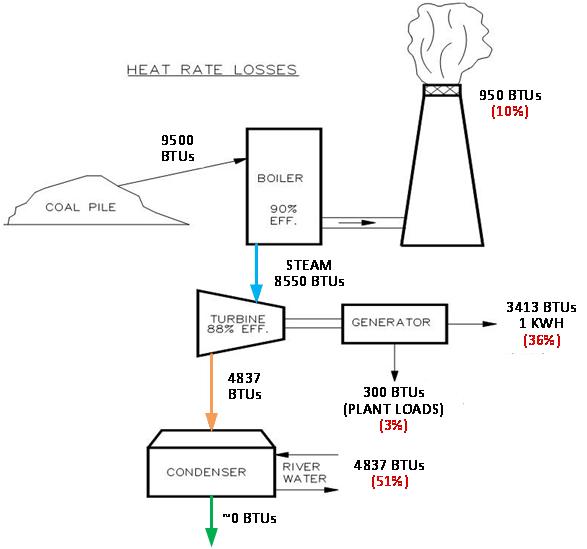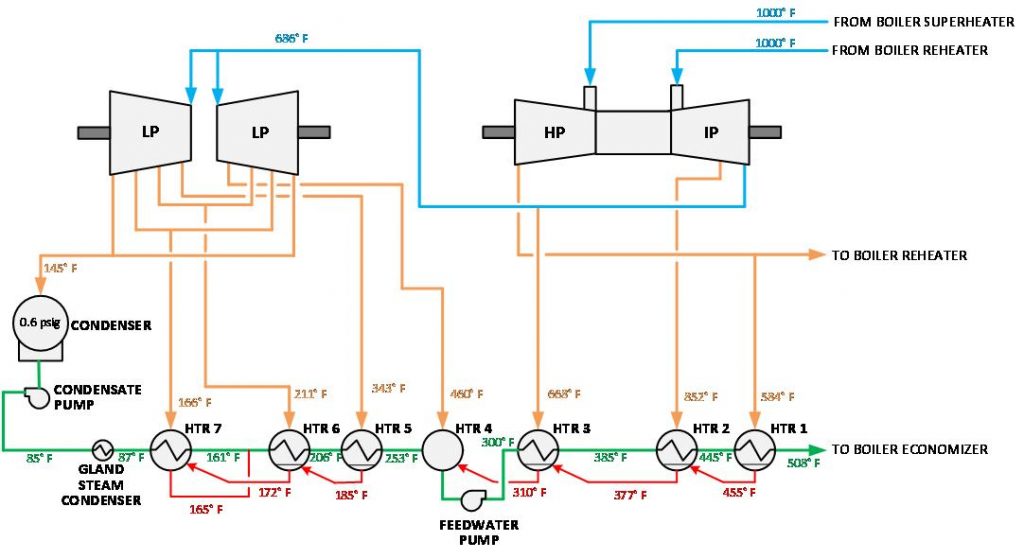
Today’s blog is the first in a three-part series about identifying issues with feedwater heaters. Over the next few weeks, the series will discuss why feedwater heaters are important to efficient plant operations, how health of feedwater heaters can be determined, and common level control and feedwater heater problems that occur during operation of the heaters.
Feedwater heaters are components of Rankine cycle power plants that typically do not receive much attention. They just do their thing, condensing extraction stream from the turbine and sending condensate back to the condenser, and heating the feedwater in the process. However, ignoring the feedwater heaters means you take the risk of major efficiency losses within the plant. By checking a few basic parameters for each heater, an operator can quickly determine the “health” of that feedwater heater. This three-part series will explain the thermodynamic function of feedwater heaters as related to power plant heat cycle, discuss measurements to use to evaluate heater performance, and describe the basic concepts of heater level control and problems arising from improper level control and other factors.
The efficiency of fossil fuel, Rankine cycle power plants vary widely, typically from 38% to 25%. If we assume a relatively efficient plant has 36% efficiency, meaning that for every BTU of fuel energy input to the plant, the equivalent of 0.36 BTU of electrical energy is output from the plant. The other 64% of the fuel energy is wasted. Figure 1 provides a rough accounting of where the energy in the fuel:
That last one should be an eye-opener. Over half of the energy supplied to the power plant is lost in the condenser, where that heat appears as an increase in the temperature of the circulating water flowing through the condenser tubes. There is no way to eliminate the condenser in the Rankine cycle, and in fact it serves two important functions:
An issue in the design of the Rankine cycle power plant is minimizing the losses from the condenser. This is where feedwater heaters come in. Feedwater heaters are installed to increase plant efficiency by decreasing heat losses to the condenser.

Figure 1 – Plant Heat Rate Losses
Figure 2 shows the steam and water cycle for a typical Rankine cycle power plant with seven feedwater heaters (a typical number) installed in the feedwater and condensate flowpaths. Some of the energy in the steam is converted to mechanical energy in the turbine. There is still energy in the steam that can be used to heat the feedwater. This energy bypasses the condenser, thus maintaining this energy in the Rankine Cycle.
Some will say that this is improving efficiency by preheating the feedwater. Indeed, the feedwater temperature in the example if Figure 2 is increased from 85°F to 508°F during its path through the heaters. This represents 423°F in temperature that the boiler does NOT need to add to the feedwater, so this does represent an increase in efficiency.

Figure 2 – Steam and Condensate Cycle with Feedwater Heaters
The real impact on increased system efficiency may be seen by analyzing the thermal energy (enthalpy) that is maintained in the system that would have otherwise been lost to the river or cooling tower. This energy represents the latent heat of vaporization that is removed from the steam to condense it to liquid water.
When this phase transformation occurs in the condenser this enthalpy is being transferred to the condenser tubes, which discharged the energy to the environment. However, when the phase transformer occurs in a feedwater heater, the enthalpy stays in the cycle and does not have to be added back in by the boiler.
Part 2 of Series: Determining the Health of Feedwater Heaters
Part 3 of Series: Level Control and Feedwater Heater Problems